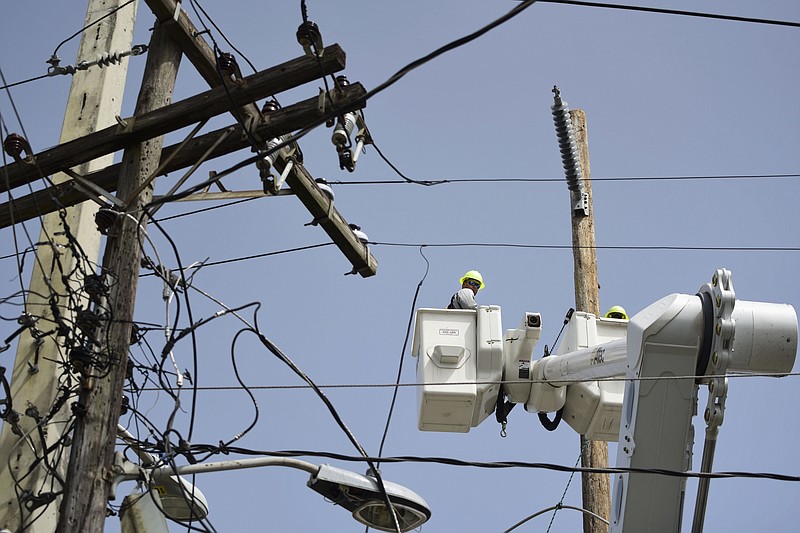BARCELONETA, Puerto Rico (AP) - Electrical linemen descend from helicopters, balancing on steel girders 90 feet high on transmission towers in the mountains of central Puerto Rico, far from any road. At the same time, crews fan out across the battered island, erecting light poles and power lines in a block by block slog.
A month after Hurricane Maria rolled across the center of Puerto Rico, the power is still out for the vast majority of people on the island as the work to restore hundreds of miles of transmission lines and thousands of miles of distribution lines grinds on for crews toiling under a blazing tropical sun.
And it won't get done soon without more workers, more equipment and more money, according to everyone involved in the effort.
"It's too much for us alone," Nelson Velez, a regional director for the Puerto Rican power authority, said as he supervised crews working along a busy street in Isla Verde, just east of San Juan, on a recent afternoon. "We have just so many, so many areas affected."
The office of Gov. Ricardo Rossello said Thursday that about 20 percent of the island has service and he has pledged to get that to 95 percent by Dec. 31. For now, though, most of the island's 3.4 million people suffer without air conditioning or basic necessities. Many have resorted to using washboards, now frequently seen for sale along the side of the road, to clean clothes, and sleeping on their balconies and flocking to any open restaurants for relief from daytime temperatures above 90 degrees.
"I thought we would we have power in the metro area by now," said Pablo Martinez, an air conditioning technician, shaking his head in frustration.
Hurricane Maria, which caused at least 49 deaths on the island, made landfall on the southeastern coast near Yabucoa as a Category 4 storm, with maximum sustained winds of about 154 mph. It passed out of the territory about 12 hours later near Barceloneta in the north, still with sustained winds of about 115 mph. The onslaught was sufficient to knock down hundreds of transmission towers and thousands of distribution poles and lines.
The storm's path was ideal for taking down the entire grid. Most of Puerto Rico's generating capacity is along the southern coast and most consumption is in the north around San Juan, with steel and aluminum transmission towers up to 90 feet tall running through the mountains in the middle. At least 10 towers fell along the most important transmission line that runs to the capital, entangling it with a secondary one that runs parallel and that lost about two dozen towers in a hard-to-reach area in the center of the island.
"It reminds me of a fireball that just burned everything in its path," said Brig. Gen. Diana Holland, commander of the Army Corps of Engineers unit working to clear debris and restore the grid, with nearly 400 troops on the ground.
The storm also struck at a terrible time. The Puerto Rico Electric Power Authority filed for bankruptcy in July. It has put off badly needed maintenance and had just finished dealing with outages from Hurricane Irma in early September.
"You stop doing your typical deferred maintenance, and so you become even that much more susceptible to a storm like Maria and Irma coming and blowing down your towers, water coming up in your substations and flooding them," said Tom Lewis, president of the U.S. division of Louis Berger, which has been supplying generators in Puerto Rico to clients that include the Federal Emergency Management Agency. "Everything becomes that much more sensitive to any kind of damage whether it be from wind or water."

